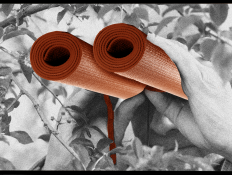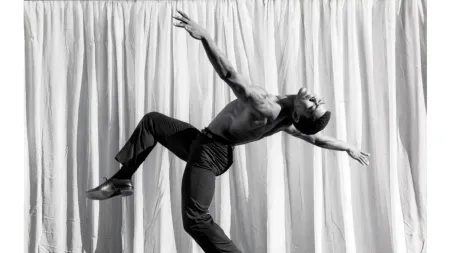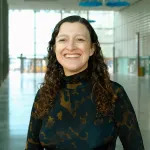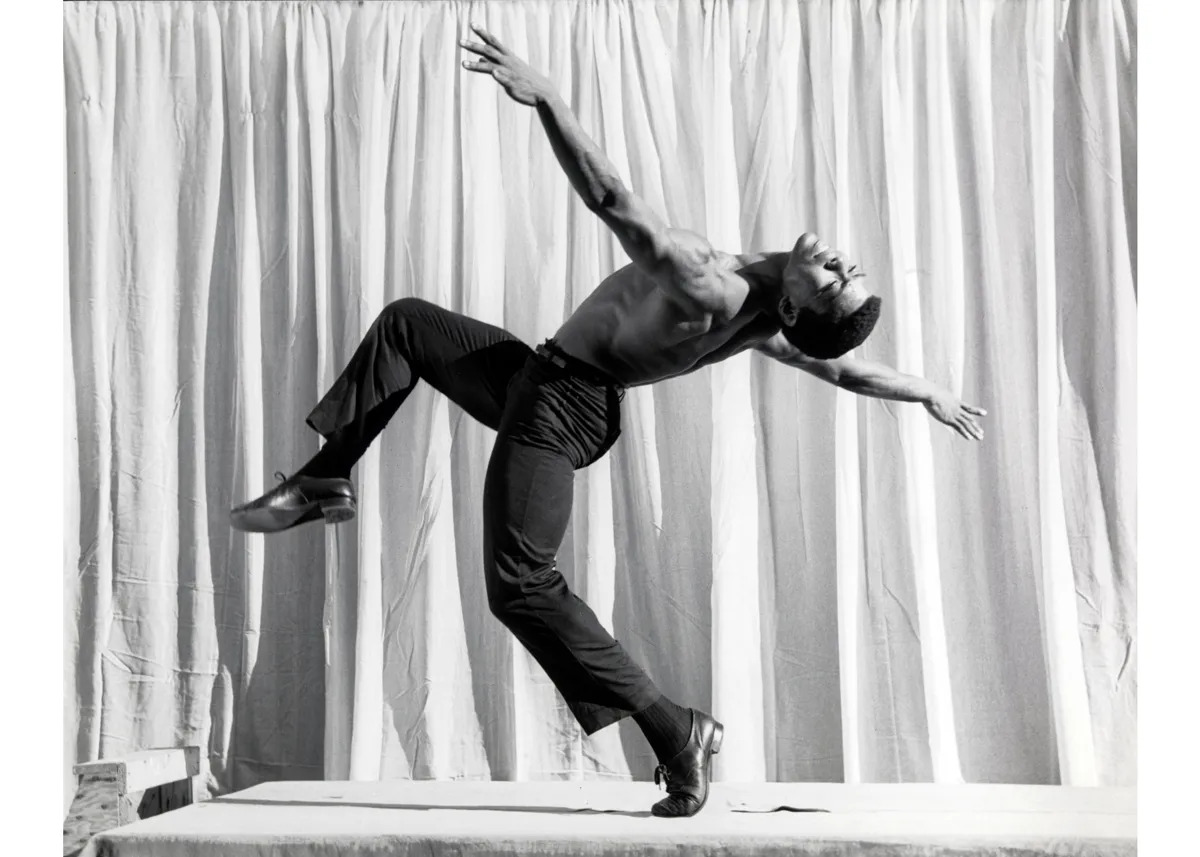
Dancers of the Alvin Ailey American Dance Theater stretch their arms out wide like wings. At once, their elbows rise from the strength of their shoulders with fingertips pointed out. They’re bathed in amber light as they slowly lift their heads out of the shadows, and upward.
This is the iconic image of Alvin Ailey’s Revelations that fans know today. Ailey created his signature work in 1958, consisting of 16 sections packed with dance and a live vocal chorus. When it premiered two years later at the 92nd Street Y in New York, he had trimmed it to 10 sections, though it still ran over an hour long. Then in 1962, Ailey condensed it into three sections so that it could tour across the US, leaving plenty of the work’s original genius on the cutting room floor.
The company hasn’t performed the original 1960 version of Revelations since.
That will change beginning in November, when choreographer Matthew Rushing, the company’s interim artistic director, will present a reimagined version of the full-length Revelations as part of the performance series for the Whitney Museum’s just opened exhibition focusing on the work and legacy of Ailey. Titled “Edges of Ailey,” it is the first large-scale museum exhibition celebrating the modern dance pioneer and covers all parts of his life, from his growing up in the South to his move to New York, where he established his now quintessential dance troupe. Rushing’s work, Sacred Songs, aims to honor Ailey’s approach to movement and connection to spirituality by bringing it to today’s audiences.
“In order for me to have started the whole project, I needed a why,” Rushing told ARTnews in a recent interview. “I needed my own personal why as to why I’m doing this. It wasn’t enough just to say, ‘I want to honor Revelations.’”
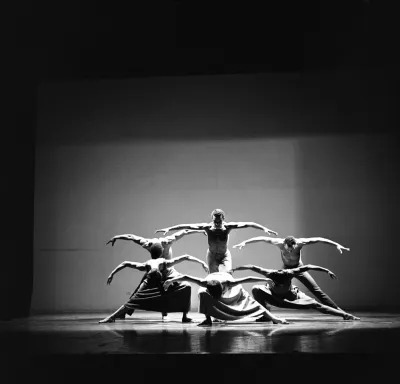
He originally planned to create Sacred Songs to celebrate the 60th anniversary of the 1960 performance of Revelations in 2020 at Lincoln Center, but the pandemic scrapped those plans. When Adrienne Edwards, senior curator and associate director of curatorial programs at the Whitney, commissioned a work from Rushing for “Edges of Ailey,” the idea behind Sacred Songs returned when re-reading Jennifer Dunning’s 1996 biography of Ailey.
Rushing joined the Ailey company as a dancer in 1992, about two years after the founder’s untimely death in 1989, before becoming the rehearsal director in 2010; he rose to the role of associate artistic director in January 2020. He had a strong connection and familiarity with the work, gravitating toward the spirituals in Revelations. When conceptualizing Sacred Songs, his aim was to resurrect—revitalize even—the omitted songs.
“Me dancing Revelations for decades, one of the things that kept it fresh for me was the music,” he said. “It was just so rich.”
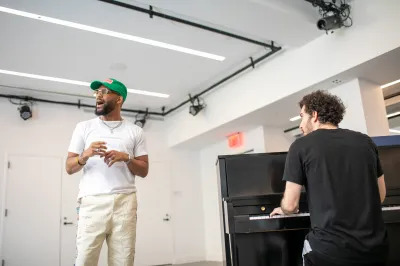
Rushing considers his new work a dance theater production because it isn’t just dance. To truly pay homage to the original Revelations, the piece also needed to be a concert with a choral group. To accomplish that goal, he employed the help of musical director Du’Bois A’Keen.
Rushing reached out to A’Keen with the ideas, sounds, and sensations he wanted to achieve. They tested these experiments out during a two-week residency at the 92nd Street Y, the same place Revelations had premiered over half a century ago. A’Keen brought together a band and vocalists to collaborate. Rushing’s main goal was to make the spirituals legible to today’s youth. “In order to make this idea accessible to a new generation, the music had to be reimagined and there had to be a new sound for today,” he said.
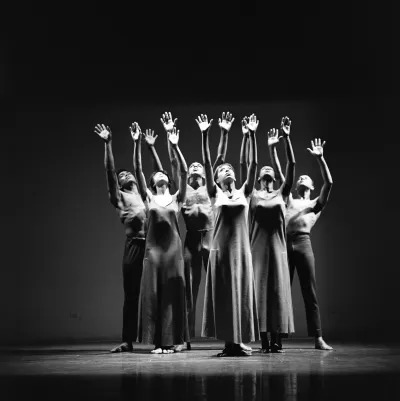
Over the course of those two weeks in June, A’Keen rearranged the songs and presented them in a new way that fit Rushing’s vision. While the music may sound different, it centers on three core themes: lamentation, faith, and hope/joy.
“As I dove into these three ideas, I thought about the importance of using music in a cathartic way, as enslaved people used it during their time,” Rushing said. “That way of processing their pain and turning it into power through music is a timeless idea.”
He doesn’t want to lose the songs that fueled Ailey’s artistry. He considers them sacred, hence the name of the piece. “What makes them sacred and timeless is not just the sound, but the spirit that’s captured in the song,” Rushing said. “I think that’s what I wanted to do: capture the spirit, the purity of the spiritual.”
He connects the idea of processing pain to the current moment, specifically the impact of the pandemic. Music kept him grounded during isolation. While his playlist may not have included spirituals, the songs “gave me the strength to literally get up off the bed and continue life,” he said.
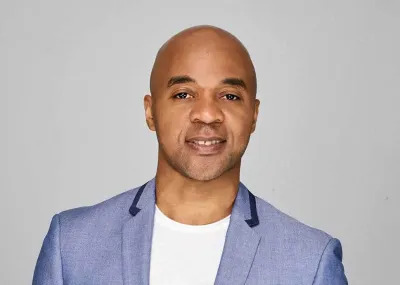
Rushing started working on Sacred Songsin earnest in June, rehearsing with dancers on the weekends. Rehearsals will continue through the work’s debut, running from November 1–3 at the Whitney in its third-floor theater space; Sacred Songs is also a part of AAADT’s season and will be performed at the New York City Center later this year.
To realize Sacred Songs, Rushing worked with dancers from Ailey Extension, a group of non-professional dancers who have other careers—ranging from a neurosurgeon to a police officer—but also have a passion for dance. Their background brought a new collaborative tone into the rehearsal room. The process began with deep discussions on the themes of the spirituals.
As the dancers gathered in the rehearsal studio, Rushing asked them, “What are the hard questions of the day?” One dancer replied, “Am I enough?”; another said, “Will I fulfill my purpose?”
These thought-provoking questions guided the process, with their queries being incorporated into a musical work that features in Sacred Songs, honoring their contributions and capturing this moment of collaboration. “To hear the song, it takes me back to that day where people were so vulnerable and so open and sharing some of their heart,” Rushing said.
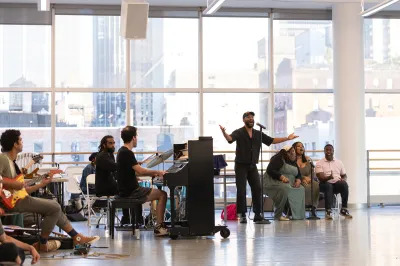
Rushing initially envisioned choreographing two versions of Sacred Songs for this season, one using the Extension dancers and another with the AAADT company, as a way to push the performance to another level. As he worked through the rehearsals, however, he realized there was no other level to reach. He learned to embrace the simplicity that he had achieved with the Extension dancers. And in doing so, Rushing feels he is honoring the simplicity that is inherent across Ailey’s oeuvre.
“I am seeing that the simple movement is working for both the professional and non-professional, and it’s beautiful,” he said. “I think it has a lot to do with his humanity.”
While Ailey’s spirit informs the work, Rushing said he didn’t want to copy the late dancer’s movements one for one. Of course, some of Ailey’s movements remain, as Rushing has danced his works for decades—it’s in his body. “There are certain moments where I allowed it to happen, and then certain moments I was like, ‘A little too similar. Let’s rethink that movement quality,’” he said.
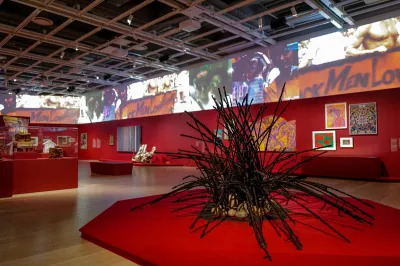
“Edges of Ailey” is organized into 10 sections, spread across the Whitney’s fifth floor. Among the themes the exhibition takes up are Ailey’s interest in Black spirituality, Black liberation, the Great Migration, Black music, and more. Throughout the exhibition, visitors see, through Ailey’s notebooks, how the visual arts informed the dances Ailey would go on to create.
“Once we had really gone through all of his personal notebooks, which took a lot of time in those thousands of pages of paper, I was really blown away and actually deeply, profoundly encouraged by what we found there, which was this deep and abundant interest in the visual arts,” Edwards, the Whitney curator, said.
Edwards’s curation is directly inspired from what she found in these notebooks, which she consulted over the course of six years. (They are currently on long-term loan at the Black Archives of Mid-America in Kansas City, courtesy of local community figure Allan Gray, to whom Ailey bequeathed the notebooks.) Edwards recalled Ailey referencing dance as “movements full of images,” she said, adding that Ailey’s dancers often spoke about how Ailey “insisted that they go to art museums when they were on tour. Wherever they went, he was like, ‘You need to go to an art museum.’”
While visitors can visually see the artistic inspirations in the exhibition space at the Whitney, they can also see it in the performance series. The series includes weeks where the Ailey company will conduct classes and workshops from the Ailey Extension program, performances by its two repertory companies, AAADT and Ailey II, and conduct showcases of The Ailey School. Meanwhile, Edwards also commissioned a number of famed dancers, including Rushing, Trajal Harrell, Bill T. Jones, Ralph Lemon with Kevin Beasley, Sarah Michelson, Okwui Okpokwasili with Peter Born, Will Rawls, Yusha-Marie Sorzano, and Jawole Willa Jo Zollar.
For Rushing, he found that the exhibition exposes who influenced Ailey, and whom he influenced. Some are obvious, like himself, but others are unexpected, like Lemon, “showing the edges of Ailey that maybe we are not familiar with, the touch points and the lives that have been affected,” he said.
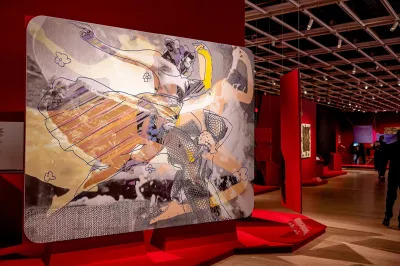
For example, artist Mickalene Thomas saw Revelations for the first time after she moved to New York in 1995. Dance quickly became a part of Thomas’s artistic practice and life. For the exhibition, she has created a work centered on Katherine Dunham, the legendary dancer to whom Ailey paid tribute at Carnegie Hall in the late ’80s. In the work, she layers three images of Dunham with a double exposure so that they bleed into one another and capture the choreographer in flight, surrounding her in orange hues and cross-hatched textures.
Revelations is a touchstone for all. Rushing doesn’t throw the word out a lot, but he makes an exception for a figure like Ailey, whose work while easy to grasp has had an outsize impact on today’s artistic landscape.
“If you are Black and dancing since his arrival, whether you’re with or differentiating yourself from him and his choreography, you’re still going through him,” Edwards said. “You’re still going and contending with that legacy.”
Viennacontemporary’s New Director Wants to Show Vienna’s Rising Stature in Contemporary Art
Rheim Alkadhi Offers a Path Toward Liberation in Palestine-Themed Artworks in London

Ralph Lauren’s New Vintage Program Makes the Brand’s Rare Threads Easier to Find

Alix Earle Gives the Oversize Jacket Trend a Fiery Twist at the Isabel Marant Show During Paris Fashion Week

Here’s why you should get ready to pay a lot more for ChatGPT Plus

Randy Orton Tattoos in WWE 2K Raise Copyright Concerns
